SHADES OF SUMMER
PEOPLE HOSPITALITY GUIDES RECIPES PLACES ARCHITECTURE




Welcome
Note from us at Fritz Hansen
The Kjærholm’s haven by the sea
Thomas Kjærholm shows us around the summerhouse designed by his mother
Summertime with Arvin Olano
A visit to sunny California to the interior designer’s Eichler home
The Sea Ranch Lodge
An architectural experiment of the 1960s, now a living testament to sustainable design
Simple pleasures, Mallorca-style
A Dane abroad – Lisbeth Fuglsang Keldsen on living the Mediterranean dream
A life well lived
Annika Zobel Agerled and Karl Oskar Olsen know how to enjoy Danish summertime
Outdoor cleaning guide
Step-by-step guide to cleaning outdoor wooden furniture
Outdoor wood oiling guide
The right way to apply oil to outdoor wooden furniture explained
Atelier September
Probably Copenhagen’s coolest cafe
NOT A HOTEL
Contemplating accommodations deep in the Japanese forest
Hugo’s summer
Designer Hugo Passos answers questions about summer in Copenhagen
Svinkløv Badehotel
The idyllic Danish summer retreat way up in the windswept north
A fusion of cultures in architecture
Architect Xiao He connects Chinese and Swedish cultures in contemporary design
Sanna’s summer
Sanna Wåhlin, interior architect & partner at Note Design Studio, talks summer inspirations
Awakening senses
Marianne Tromborg’s summer rituals at her house by the coast
Summer reads with Els Van Hoorebeeck
Our creative director shares her book recommendations
Designs on summer
Can you solve the crossword puzzle?

At its heart, this magazine is a dedication to summer - the paradoxical season that feels endless yet always slips away too soon. It carries with it joy and nostalgia, intensity and restlessness. It’s the time we associate with both stillness and adventure, with childhood freedom and the rituals we carry into adulthood.
One theme echoed by nearly everyone we spoke to for this edition was the experience of eating outdoors—the simple but profound pleasure of sharing a meal under the open sky. “We eat outside in our garden as often as we can - taste and flavour are enhanced by the outdoor elements,” says Annika Zobel Agerled, founder of Akua Objects.
But it’s not only flavours that are enhanced.
Outdoor spaces shape the way we experience summer. They become places of gathering, relaxation, and connection with nature - extensions of our homes, just without walls. “I think it’s important to have spaces where you can gather outdoors to feel connected to nature,” one of our interviewees shared. “A cozy seating arrangement, a dining table, and lighting are all key for outdoor spaces, much like they are indoors.”
Whether it’s a sunlit terrace, a shaded garden, or a balcony just big enough for two, the outdoors invites us to slow down and soak in the season. To help capture the essence of summer, we invited a diverse group of voicesarchitects, designers, business owners, interior designers, art collectors, and hoteliers - from Denmark, California, Japan, Mallorca, Portugal, and Sweden. Together, they share what summer looks like, tastes like, and feels like in their part of the world. Several of them shared their favourite summer flavours as recipes for you to try, from fresh lemonade to fruit preserves, and even the internationally little-known but nationally adored Danish summer dessert, Koldskål (literally “cold bowl” - a name that does little to stir the imagination, but trust us, it’s worth a try).
And as their stories unfold, one thing becomes clear: summer has a way of sticking with us. It lingers in the warmth of sun-soaked chairs, in the memories of the past and longing for the next sunny day, in the faint scent of sunscreen on a sweater you forgot to wash. As the days shorten and autumn creeps in, traces of summer remainsometimes in the form of a half-melted ice cream memory, other times as a stubborn tan line that refuses to fade. Even the furniture remembers - teak tables and chairs, once golden, gradually turning silver, as if summer itself had left its mark.
For Thomas Kjærholm, the summerhouse in Northern Zealand is more than just a retreat; it is a living testament to his family’s deep connection to design, nature, and togetherness. The house, a gift from his mother, architect Hanne Kjærholm, was designed with both intention and intuition, seamlessly blending with its coastal surroundings.
Words: Susanne Morell Adams
Photography: Line Klein


Thomas is the son of two visionary creatives - his mother, Hanne Kjærholm, a highly regarded architect, and his father, Poul Kjærholm, one of Denmark’s most celebrated furniture designers. Poul was renowned for his refined, minimalist aesthetic, favouring steel and natural materials to create timeless, functional designs. Hanne, an architect and professor at the Royal Danish Academy of Fine Arts, was known for her rigorous approach to spatial composition and materiality, which she often infused with elements of Japanese and Chinese architectural principles. Their shared appreciation for craftsmanship and thoughtful design is beautifully encapsulated in the summerhouse she designed for Thomas and his family.
"We love following the sun around the house,” Thomas shares. “In the mornings, we sit on the east side, enjoying the first rays of sunshine, and in the evenings, we relax in the warmth of the setting sun. I adore how the house has these beautiful sunspots."
Completed in 2003, the summerhouse sits parallel to the coastline, taking full advantage of its spectacular views over the Kattegat Sea, with the cliffs of Kullen in Sweden visible on clear days. The house is defined by its tripartite structure, a concept inspired by Chinese architecture, with two enclosed sections and an open central passage that extends into a terrace. This design creates a fluid transition between indoors and outdoors, allowing the rhythms of nature to shape daily life.
“It is a Chinese-inspired house in the sense that I have designed a tripartite house, with two closed sections and a hole in the middle,” Hanne Kjærholm once explained. “And to emphasize this opening, I made a terrace that runs through the house and continues on the other side, cutting the house in three, both in plan and as a whole. This creates a basis for the furnishing, where these possibilities are fully utilized.”




"Family grill evenings are a highlight, with everyone gathered around the table."
The influence of Japanese architecture is also evident, particularly in its resemblance to the Horyu-ji temple’s treasury, which features a similar tripartite division under a single roof. The house’s elongated rectangular form is punctuated by a 45-degree saddle roof, with dormer windows that open towards the sea while shielding the house from neighbouring summerhouses. A skylight runs along the ridge of the roof, allowing natural light to flood the interiors.
The materials are chosen for both their aesthetic and functional qualities. Solid, untreated pine tree trunks serve as the primary structural columns, their natural knots and forms preserved to create a raw, organic presence reminiscent of Viking architecture. These sturdy elements contrast with the blackstained wooden exterior, emphasising the interplay between tradition and modernity. Inside, Italian marble floors extend onto the terraces, blurring the boundary between interior and exterior spaces.
The transparent middle section of the house, where the kitchen and dining area are located, is oriented towards both the sea view and the sun. Large windows on the north and south sides pull back more than a metre from the outer walls, where top-hung shutters, as large as garage doors, provide both shelter and security when the house is not in use. The steel
furnishings, including the stairway and fixed interior elements, reflect Hanne’s meticulous approach to material refinement, while wood-burning stoves add warmth and comfort.
On warm summer days, Thomas and his family gather around the Selandia dining table outside, where meals become cherished moments. “Our summer rituals are even more special with the grandchildren around,” he says. “Family grill evenings are a highlight, with everyone gathered around the table.” The outdoor dining area, positioned to face the sea, enhances the joy of alfresco meals, accompanied by the gentle sound of waves lapping at the shore.
“Watching the sunrise by the sea is a tradition we cherish,” shares Thomas. Here, the vast expanse of the sea creates a serene backdrop for contemplative moments, making it a perfect spot to connect with nature.
Hanne Kjærholm’s summerhouse is more than just an architectural accomplishment; it is a home that captures the essence of Danish summer—a place for family, for quiet reflection, and for embracing the beauty of the natural world. The balance of simplicity and complexity in its design ensures that it remains a timeless retreat, celebrating the intersection of heritage and innovation. ■



1 vanilla pod
400 g sugar
250 g rose hips, washed
250 g apple, cubed
50 g sea buckthorn
1 organic orange, juice and finely grated orange zest
Instructions:
1. Split the vanilla pod lengthwise, scrape out the seeds and rub into the sugar.
2. Place the rose hips, apple cubes, sea buckthorn, orange zest, orange juice, sugar and the empty vanilla pod into a pot and bring it to a boil.
3. Let it simmer with the lid on for 15 minutes, stirring a couple of times along the way. Blend the jam with a hand blender if you prefer a creamier consistency.
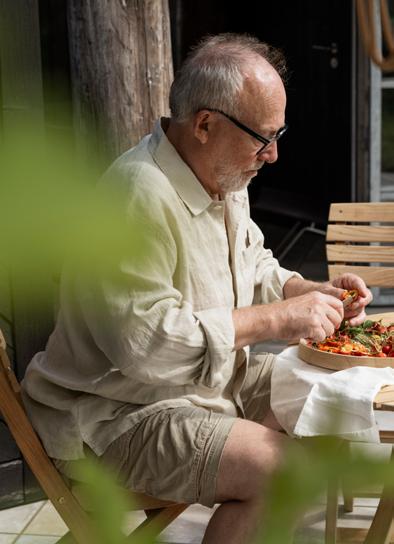
4. Sterilize a couple of well-cleaned jars thoroughly and shake them with a bit of alcohol if needed.
5. Pour the finished jam into the jars and seal tightly.
Tip: To prepare rose hips, slice off the flower and stem then cut in half and remove the seeds with a teaspoon or small knife. Pick approximately double the amount to reach the correct amount the recipe calls for. Fills 2-3 medium jars (250ml approx)
Words: Susanne Morell Adams
Photography: Madeline Tolle
Summertime reminds interior designer Arvin Olano of his childhood in the Philippines when freedom and a sense of endless time echoed vividly in his memory. “When you’re young, summer has a completely different meaning. It’s a time when you are free to do whatever you want, and it never seems to end.”


Today, Arvin lives in California with his husband and their two French bulldogs, Marble and Sage. Their 1964 Eichler home is precisely the mid-century architecture the design-conscious creator dreamed about. Floor-to-ceiling windows throughout the house allow natural light to flood in.
“I love the simple ritual of going from hot coffee to iced coffee once the weather starts to warm up. Every day I wake up at 6:30 in the morning before my husband and our two dogs, and I take an hour for myself to make my coffee or read a book.”
For Arvin, it is important to appreciate the surrounding nature. Explaining the space, he says, “I think it’s important to have spaces where you can gather outdoors to feel connected to nature.
A cozy seating arrangement, a dining table, and lighting are all key for outdoor spaces much like they are indoors.”
"I think it’s important to have spaces where you can gather outdoors to feel connected to nature."
They placed the outdoor dining space under the shelter of the trees. Here on the verdant lawn, the Overlap table and two benches sit effortlessly with the gorgeous scenery with simple lines and wooden tops.
For Avin, the clean design of the outdoor furniture plays a strong role in his décor sensibilities; “I love the simplicity of the outdoor collection because it aligns with my own personal style. I’m drawn to honest materials, strong shapes, and craftsmanship which are all present in Fritz Hansen’s pieces.”
When asked to describe the summer perfect day, Arvin shares, “It’s spent at home with my family, my husband, and our two French bulldogs Marble and Sage. The door to the atrium and the backyard is open, music is playing, and a candle is burning.” ■


Seen from the garden, the house is hemmed in by pebbles and a patio. As if admiring the view of mountains through the trees, a soft-cushioned Tradition lounge chair with pouf invites its guest to put their feet up and bask in the view, with Overlap bench and table in front.


Words: Susanne Morell Adams
Photography: Adam Rouse
Conceived as an experiment to harmonise architecture with nature, Sea Ranch Lodge quickly became a shining symbol of California’s architectural heritage. Over time, it has grown into a living testament to sustainable design, where architecture blends seamlessly into the surrounding beauty of the rugged natural landscape.
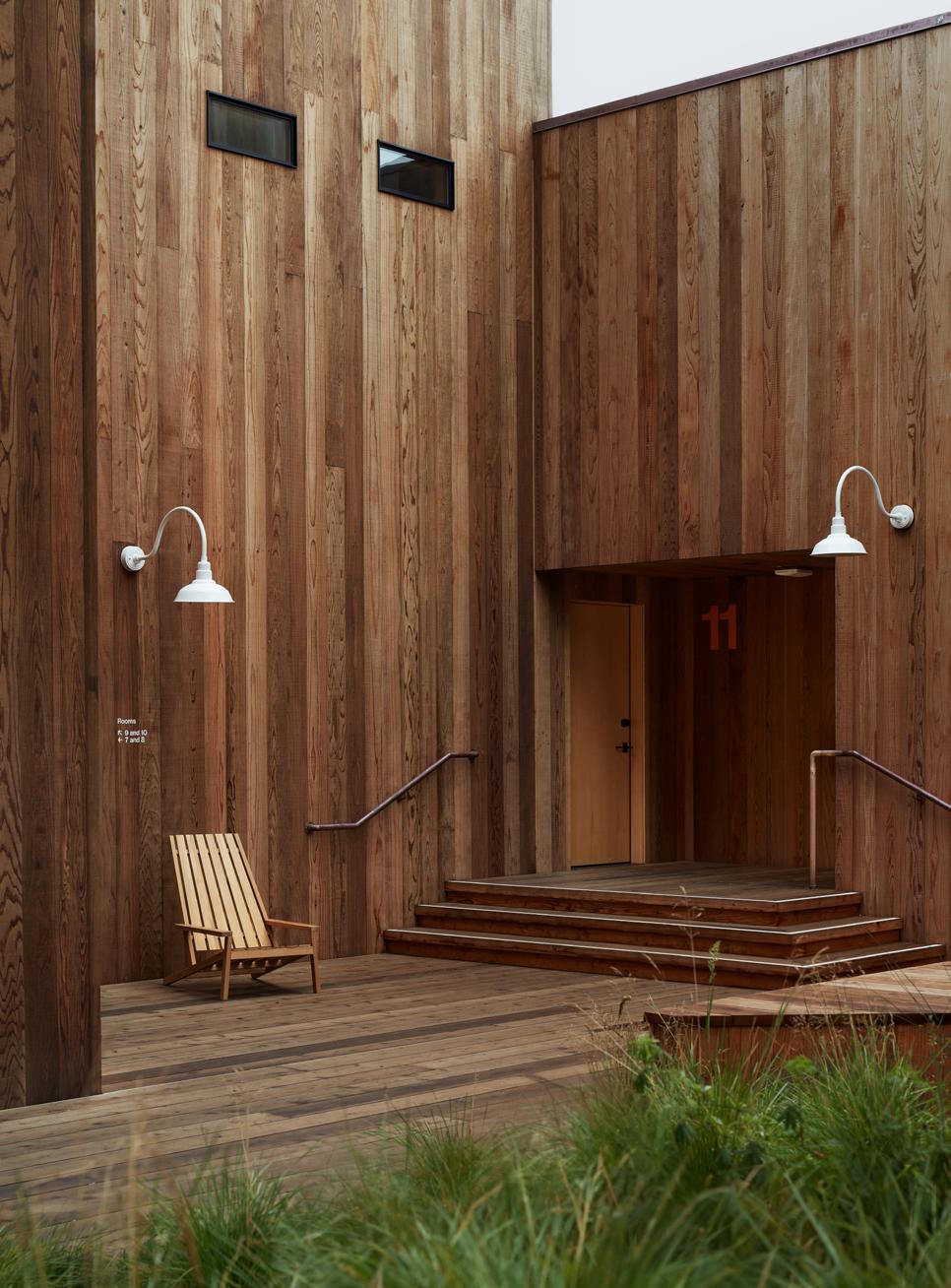


Set on the dramatic beauty of Sonoma Coast in Northern California, Sea Ranch Lodge has embodied a seamless fusion of architecture and nature since its inception in the 1960s. To the left, Cutter Stools invite pause, while on the right, Between Lines Deck Chairs are perfectly placed to take in the breathtaking view.

The history of Sea Ranch Lodge is one of visionary architecture and sustainability. Emerging as an architectural experiment in the 1960s, it has since become a symbol of sustainable design along the California coastline. The Fritz Hansen project pays tribute to this heritage by integrating with the natural setting and reflecting its commitment to enduring design principles. A recent outdoor transformation uses Fritz Hansen’s outdoor pieces. Chosen for their minimalist Nordic design and inspired by nature, the exquisitely crafted wooden benches and stools create an inviting outdoor haven for guests and residents. Among the pieces, the Cutter Bench and Stool, the Banco Bench and Between Lines deck chair harmoniously complement the Lodge’s wooden surroundings, elevating the atmosphere with modern elegance and inviting comfort.
Beyond its role as a retreat, Sea Ranch Lodge actively fosters local connections. It has a close-knit community drawn together by a shared love for the coast and a dedication to preserving the Lodge’s legacy. It also serves as a local post office, with dedicated mailboxes for each of the community’s residents. Here, neighbours meet, greet, and engage in conversations.
Subtly recessed within the architecture, the mailboxes serve as both a functional detail and a gathering place for neighbours, fostering a sense of community for the residents of Sea Ranch Lodge. Placed in front, the Banco Bench offers a place to pause and connect.
This aspect is integral to the Lodge’s history, as it not only caters to residents’ practical needs but also fosters a sense of connection and a communal space.
The recent collaboration with Fritz Hansen at Sea Ranch Lodge embodies its commitment to enduring design and respect for the beauty of its natural surroundings. This project celebrates Sea Ranch Lodge’s essence, where architecture and nature seamlessly merge, and remains a place where California’s architectural heritage thrives and the Sonoma Coast’s beauty continues to inspire. ■

The minimalistic teak Cutter stool and bench fit seamlessly into the surrounding architecture.

Lisbeth Fuglsang Keldsen, an expert in selling beautiful houses in Mallorca and an avid collector of art, has called this vibrant island home for over 22 years.
Words: Susanne Morell Adams Photography: Birgitta Wolfgang

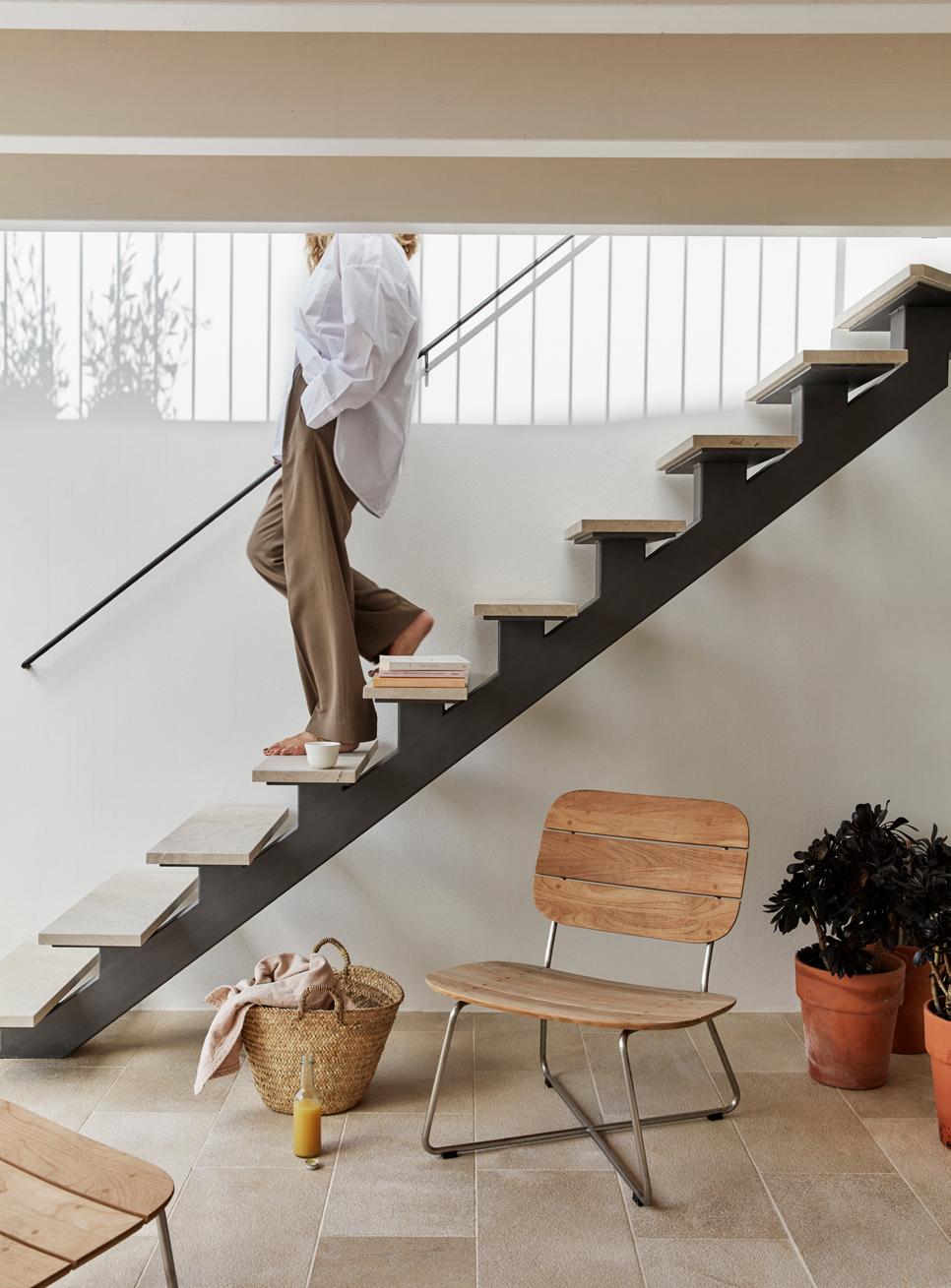

Before settling in Mallorca, Lisbeth lived in Pietrasanta, a small artist town in Italy. It was a job offer that brought her to Mallorca, a place she had never visited before moving. Now, she couldn’t imagine living anywhere else. Her job at the gallery CCA Andratx allowed her to merge her professional life with her passion for art, a passion that remains a significant part of her life on the island.
Nestled amidst the lush landscape, Lisbeth’s home seamlessly blurs the boundaries between indoor and outdoor living. ”I have been collecting art since my early twenties and love visiting galleries and art fairs around the world,” Lisbeth shares. This passion for aesthetics, design, and simplicity is evident in every detail of her Mallorca residence. ”It means a lot to me to have something beautiful to look at, both indoors and outdoors.”
When Lisbeth thinks of summer, she envisions spending time with family and friends, trips to the beach, and embracing outdoor life. ”The perfect summer day for me starts with a swim in my small pool, followed by a day at the beach with friends and family, ending with dinner on the terrace,” she describes. On the terrace overlooking her pool, a Ballare dining table and chairs sit ready for the next outdoor dining occasion.
"It means a lot to me to have something beautiful to look at, both indoors and outdoors."
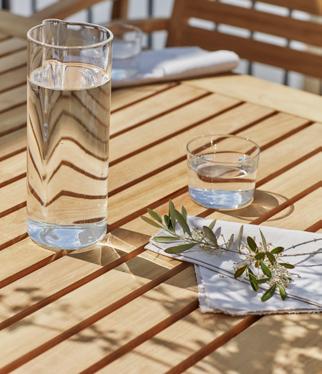


In the sun-drenched Mediterranean, where lemon trees thrive, Lisbeth has her own refreshing recipe for homemade lemonade — served here on a No. 10 Tray. Discover the recipe on page 48.
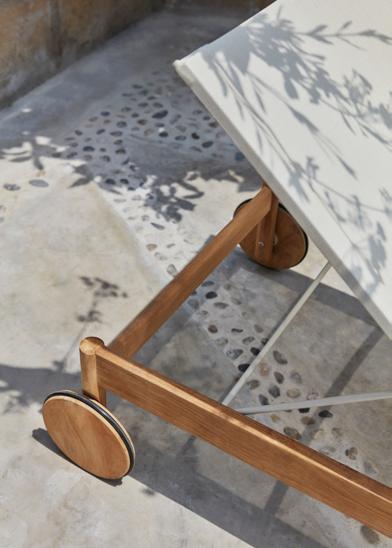

"The perfect summer day for me starts with a swim in my small pool, followed by a day at the beach with friends and family, ending with dinner on the terrace."


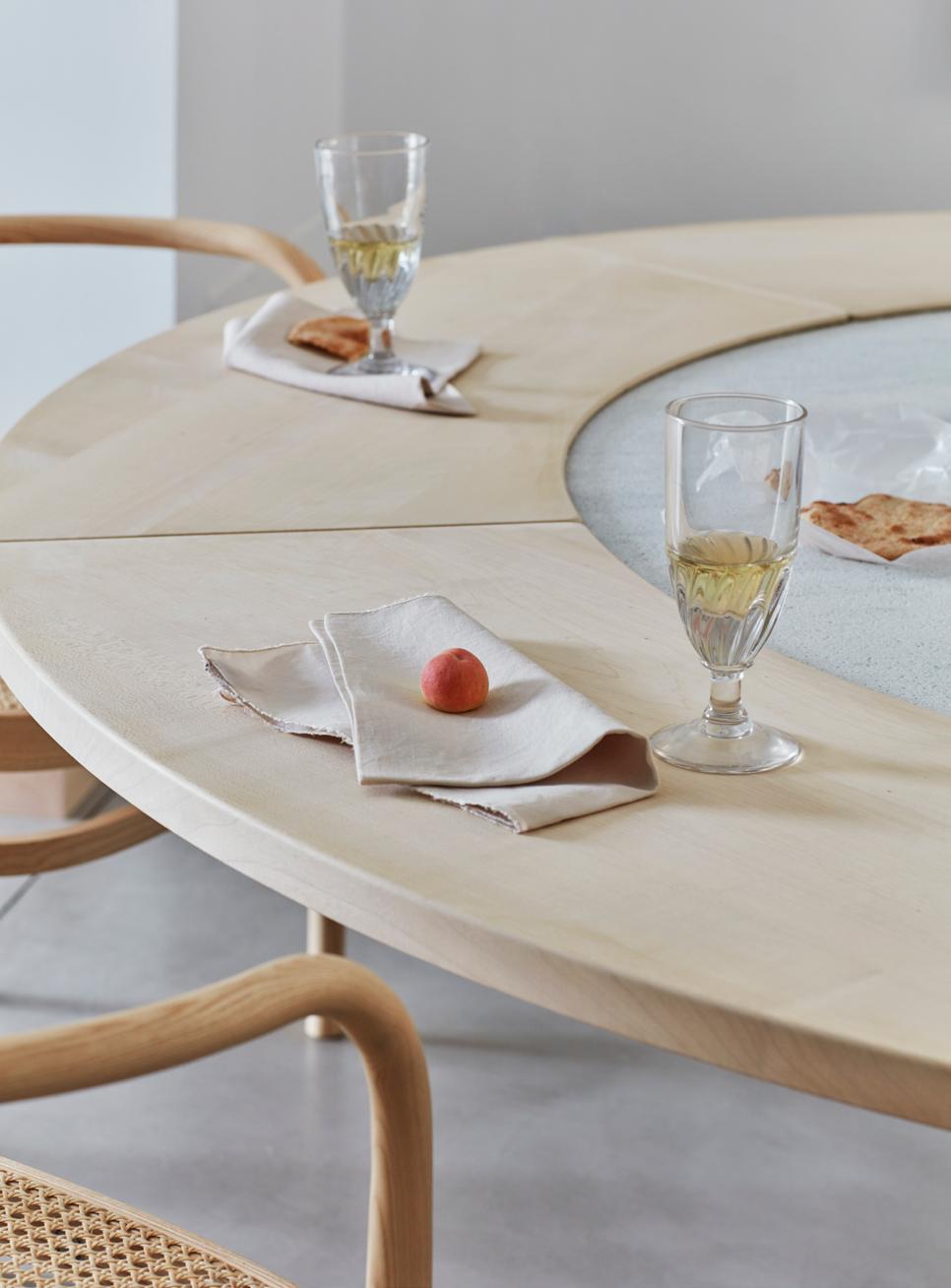
One of her cherished summer rituals is making homemade lemonade from her garden’s lemon tree. The terrace, connected to her kitchen, is a favourite spot for cosy evenings with friends. ”During times of the year when we don’t sit outside and eat, we gather around my PK54 table, where I can set up for many guests with my extension rings.”
Lisbeth’s appreciation for simplicity and elegance extends to her choice of outdoor furniture. She favours pieces from Fritz Hansen for their minimalist design and high quality. ”I like the simplicity and the beautiful design. Even though the climate is warm, the furniture looks very beautiful when it patinates and gets a lovely grey colour,” Lisbeth notes. From the Pelagus sunbed under the shade of the Atlantis Umbrella to the Lilium chairs perfect for enjoying a morning coffee, the versatile pieces blend seamlessly into her outdoor space, enhancing both functionality and aesthetics.
For Lisbeth, summer in Mallorca is about celebrating life’s simple pleasures. ”For the love of long summer dinners under the open sky with good friends,” she concludes. It’s a celebration of nature’s beauty, the joy of togetherness, and the seamless blend of architecture and environment that defines her perfect summer day. ■
• For Art Lovers: Discover contemporary treasures at CCA Andratx, nestled in the mountains, or explore the vibrant world of Joan Miró at the Fundació Miró Mallorca.
• Sun & Sea: Soak up the sun on the stunning beaches of Sant Elm, or enjoy a scenic lunch by the water at Patiki Beach in Port de Sóller.
• Seafood Spot: Enjoy the
catch
"During times of the year when we don’t sit outside and eat, we gather around my PK54 table, where I can set up for many guests with my extension rings."

4 servings
100 g sugar
1 l water
Juice from 5 organic lemons
Ice cubes and cold water
1 organic lemon, sliced for garnish
Fresh mint, for garnish
Instructions:
1. Combine sugar and water in a saucepan.
2. Bring to a boil until the sugar is completely dissolved.
3. Remove from heat and add the freshly squeezed lemon juice.
4. Pour into a pitcher with ice cubes and add cold water to taste. Option-ally, add a few lemon slices and mint leaves.
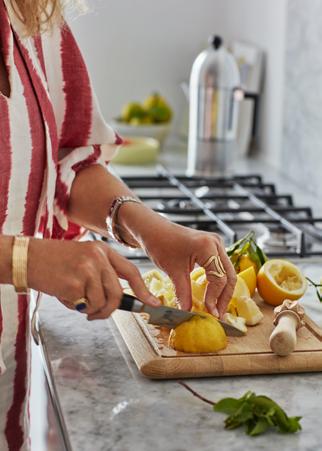



Words: Rachael Morgan
Photography: Line Klein
With a deep appreciation for design, nature and quality time with loved ones, Annika Zobel Agerled and Karl Oskar Olsen have created a life that celebrates togetherness and the joy of being outside, making the most of the Danish summer’s long, golden days.
For Annika Zobel Agerled and Karl Oskar Olsen, summer is more than just a season – it’s a way of life. As designers and creatives, their world is shaped by aesthetics, craftsmanship and an innate connection to nature. Annika, founder of Akua Objects and former fashion director at Costume magazine, has a sharp eye for blending timeless elegance with modern sensibilities. Karl Oskar, co-founder of the globally recognised streetwear brand Wood Wood and technical cycling label Pas Normal Studios, balances urban edge with a deep appreciation for craftsmanship. Together, they have created a life where design, nature and togetherness seamlessly intertwine.
Tucked away in a serene spot north of Copenhagen, their home is an extension of their design philosophy—effortlessly stylish yet deeply personal. Here, the boundaries between indoors and out blur, and the garden becomes the heart of their summer life.
“It’s where everything happens—from bathing the kids to barbequing with friends, watching films under the stars or simply lingering over a bottle of wine,” explains Annika. Surrounded by towering trees, the space has been left largely untouched, allowing nature to take centre stage. “We quickly realised the garden was perfect just as it was: lush, untamed and framed by towering trees. It’s a place where we can escape the stresses of everyday life, surrounded by birds, squirrels and the occasional fox.”
Summer, like Christmas, is a time to create lasting memories, come rain or shine. ”There’s a lightness to life in summer,” Annika reflects. ”It reminds us to pause and enjoy the moment the company of family and friends. It’s where the best memories are made.”
• Morning Ritual: Coffee in the crisp air, then cycling through the city
• Best Way to Explore: By bike – “the ultimate way to experience the rhythm of the city”
• Breakfast Spots: Lille Bakery or Morgenstedet
• Green Escapes: Kongens Have & Fælledparken – ideal for kids to roam
• Afternoon Dip: Swim in the harbour pools – a beloved city tradition
• Evening Vibes: Drinks with friends, followed by dinner at Mangia or Circolo

and

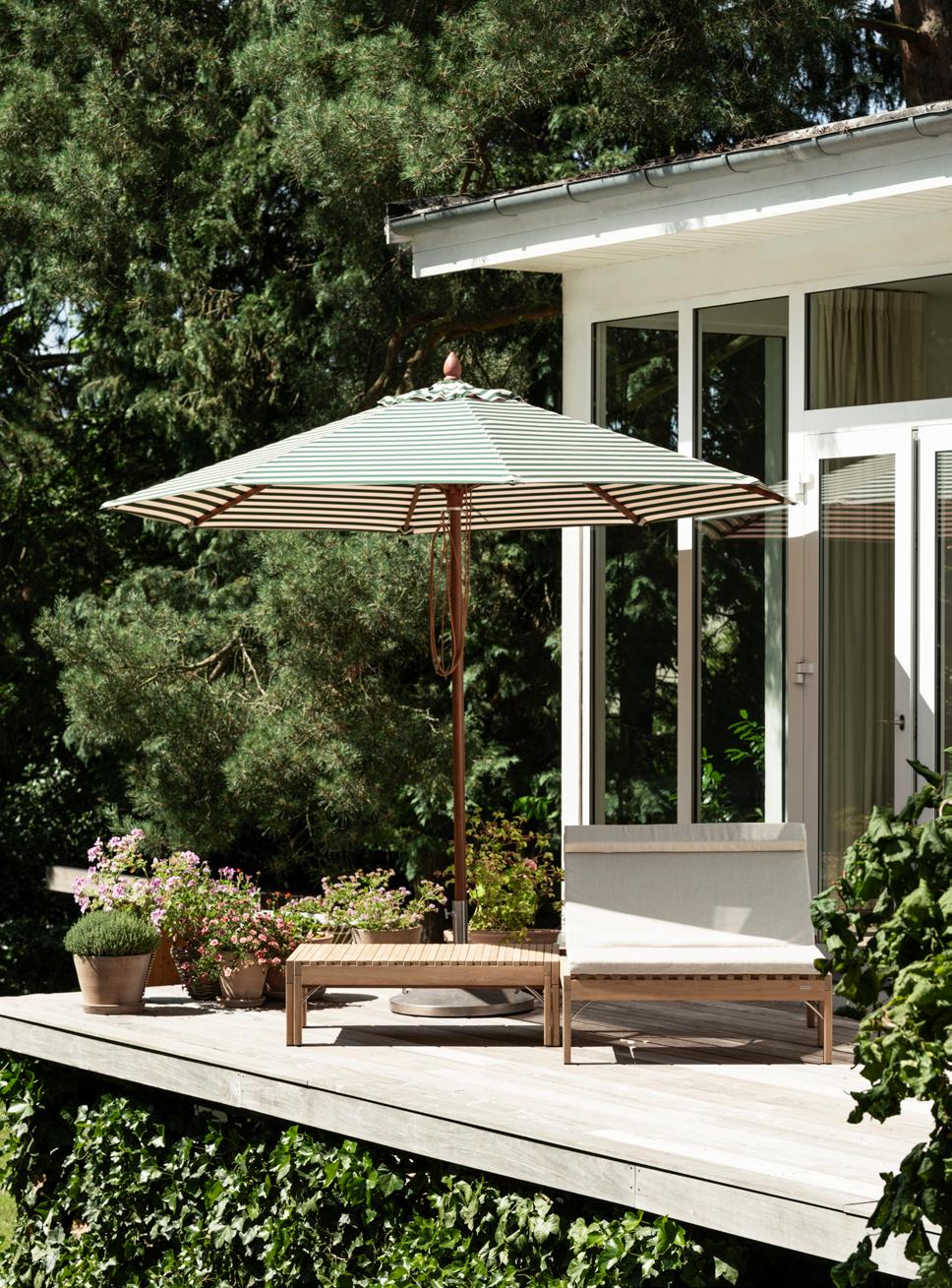



Mornings begin with coffee in the crisp air before setting out on bicycles to explore the city’s green spaces.
“Copenhagen is a city made for cycling,” says Karl Oskar. “It’s the ultimate way to experience the rhythm of the city.”
Breakfast might be at Lille Bakery or Morgenstedet before weaving through the leafy expanses of Kongens Have or Fælledparken, where their children can run free. Later, the draw of the water proves irresistible; a dip in the city’s harbour pools is a cherished ritual. “It’s pretty exceptional to live in a capital city where you can dive straight into the water.” As evening unfolds, they gather with friends for drinks in the city before settling in for dinner at Mangia or Circolo, where the wine and conversation flow long after sunset.
"There’s a lightness to life in summer. It reminds us to pause and enjoy the moment."

Much like their home’s interior – a thoughtful balance of Art Deco influences, Danish design heritage and global inspiration – their outdoor space is curated with the same discerning eye. “The best design doesn’t demand attention. It simply belongs,” says Karl Oskar.
The understated aesthetic of Fritz Hansen’s outdoor collection speaks to their sensibility: furniture that is as beautifully proportioned as it is functional. Among their favourite pieces is the Drachmann series, an elegant tribute to Danish heritage and inspired by the poet and painter Holger Drachmann’s love for nature and art. Designed in collaboration with Bernt Santesson, the teak chairs and tables reflect the couple’s own philosophy – refined yet relaxed, beautiful yet practical. “Good design ages well,” Karl Oskar notes, admiring the way the Drachmann Chair’s teak develops a silver-grey patina over time, much like their garden has evolved naturally, untouched by fleeting trends. “It’s about creating something lasting—whether it’s a chair, a home or a tradition.”
One of their most cherished spots is a small antique tile table from the 17th century, placed perfectly between the living and dining rooms. “There’s a calm aura in that corner,” says Annika. “It’s where you can collect your thoughts, looking down the house’s axis or out towards the towering pine trees.”
As the golden days of summer wane, the couple hold onto its magic. “There’s always that point in mid-February when the darkness feels endless,” Karl Oskar reflects. “But then, the first stretch of warmth and light in April feels like a monumental shift. While autumn and winter have their own melancholic charm, summer is when we recharge our batteries for the rest of the year.” And so, when summer does finally arrive, they make the most of every moment. For the love of the simple pleasure of life lived outdoors. ■


4-steps to long-lasting outdoor furniture
Our outdoor furniture collection is almost exclusively crafted using teak – a wood type that lasts a lifetime when cared for well. Learn how to take care of outdoor teak and maintain it beautifully year after year.
About Teak
Teak is our preferred choice for outdoor furniture, as it requires little care and maintenance. It is a heavy, hard, and sturdy type of wood. The high content of natural oils makes it highly weather—and rotresistant. We use only core teak because it is richer in natural oils, making it evenlygrained, more weather-resistant, and longer-lasting than outer teak wood.
The surface of untreated teak will patinate over time to eventually become a silvery grey colour. Allowing natural patination to develop does not affect the durability or quality of the material. However, to preserve or intensify the original honey-golden colour, a suitable furniture oil should be regularly applied.
Whether or not the wood is treated, teak is resistant to everyday wind and weather thanks to its high content of natural oils. However, it is important to clean outdoor furniture at least once a year to prolong its lifespan. Cleaning removes algae and dirt and makes your furniture more resistant in all weathers, all year round.



Step 1
Place the furniture on grass if possible. If not, make sure to rinse the surface under the furniture, as the soap may stain tiles or wood.
Mix water and wood cleaning soap.
Recommended dosage: 25 ml soap to 5 l of water.

Step 2
Rinse the furniture with water.
What you need:
• Water, preferably a hose
• A bucket
• Outdoor Care Kit*
*Shop the Outdoor Care Kit at fritzhansen.com. Contains a natural bristle scrub brush and Garden Wood Cleaner to prevent build up from algae, dirt, mould and mildew.

Step 3
Scrub the surface using the brush and soapy water in the direction of the woodgrain. Use repetition with moderate pressure.
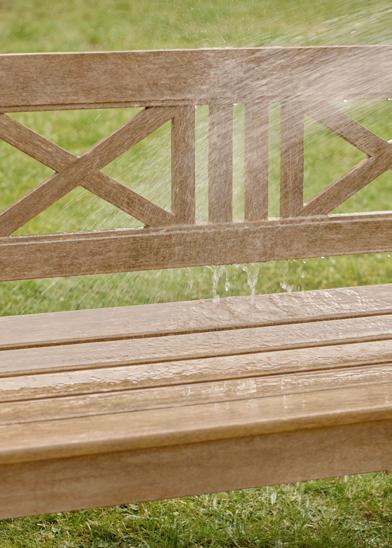
Step 4
Rinse with clean water.
Watch the cleaning guide video.
Taking care of your outdoor furniture by cleaning it at least once per year will help it to last a lifetime and keep it looking beautiful.


Oiling your outdoor wood furniture preserves or intensifies the original golden-brown colour, leaving it well-nourished and resistant to water and dirt.
Untreated wood left outside will naturally patinate over time to become silver-grey in colour. To preserve or intensify the original golden-brown colour, the wood can be regularly treated with oil.
The oil is designed to protect the wood. It brings out the grain’s natural beauty and leaves it well-nourished and resistant to water, dirt and grease. You will get the best results if you oil the furniture before it starts to patinate.
Note: It is important not to use the same oil on your indoor furniture due to strong algae removal properties in outdoor oil products.

Clean the surface thoroughly before starting the oil treatment.
Make sure to let the wood dry for at least 24 hours after cleaning. Sand down any rough fibres in the wood with sandpaper before applying the oil.

Avoid direct sunlight and high temperatures while oiling. It should be no colder than 13°C.

Step 3
Stir the oil before and while using it.
Shop outdoor oil at fritzhansen.com. For dark wood types including teak, red cedar, cherry and mahogany, the oil penetrates the grain to bring out its natural beauty and leave it protected against water and grime.

Step 4
Apply an even layer of oil with a brush or a lint-free cotton cloth. Remember to start from the bottom and work upwards to avoid streaks.

Step 5
Wipe off any excess oil with clean cotton cloths after no more than 20 minutes. Dispose of oily cloths responsibly, as they can be a fire hazard. If the surface does not appear saturated with oil, repeat steps 4 and 5 as often as necessary.

Step 6
It normally takes 48 hours for the oil to harden. The wood should not be exposed to water in this period. We recommend repeating this process 1-2 times a year. Remember to always clean the surface before starting.
Watch the oiling guide video.
Atelier September is founded by chef Frederik Bille Brahe with cafes located in the centre of Copenhagen at Kronprinsessegade, in Århusgade and a little north from Copenhagen in a city called Hellerup.
Words: Susanne Morell Adams
Photography: Emilie Holm
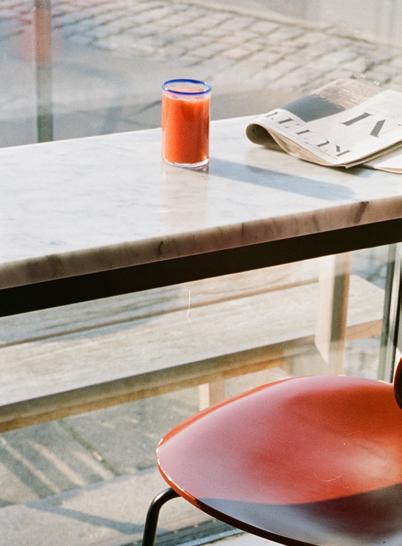


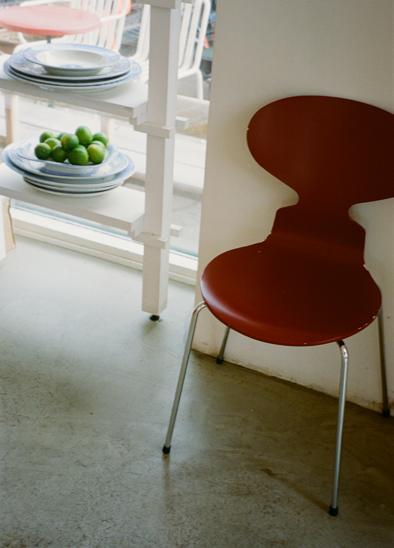
Frederik Bille Brahe, the chef who helped transform the Danish culinary scene with his creative vision at Atelier September, has shared a mouthwatering summer omelette recipe exclusively with Shades of Summera simple, flavourful dish that captures the spirit of the season. Find the recipe on the next page.
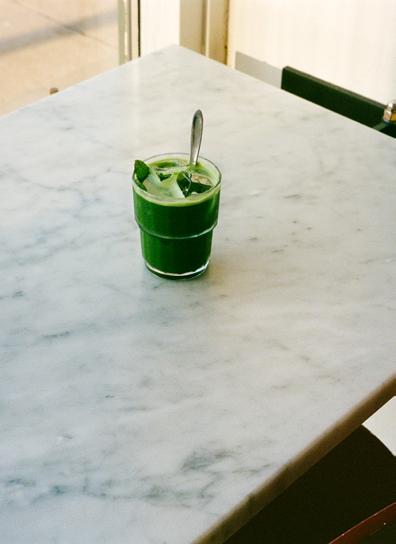
Atelier September is more than a café - it’s a thoughtfully open space where daily rituals unfold with quiet intention. Founded by chef Frederik Bille Brahe, the café now has three locations - one in the heart of Copenhagen, another in Nordhavn, and the third just north of the city in Hellerup - each offering a considered setting with an effortless vibe for everything from casual meetings to solitary pauses.
The style is distinctly minimalistic: pared back to the essentials. The interiors leave space for guests to shape the mood with their presence, creating a sense of belonging and ease. Rooted in simplicity and care, every element is intentional - just enough to frame the experience without ever overwhelming it. From the scent of freshly brewed coffee to beautifully crafted dishes, Atelier September invites you to slow down and savour the moment.
Serves 1
For the omelette
2-3 eggs
Toppings
New peas, straight out of the pod preferably
Handful of mint leaves
Handful of basil leaves
A few sprigs of fresh dill
Good quality olive oil
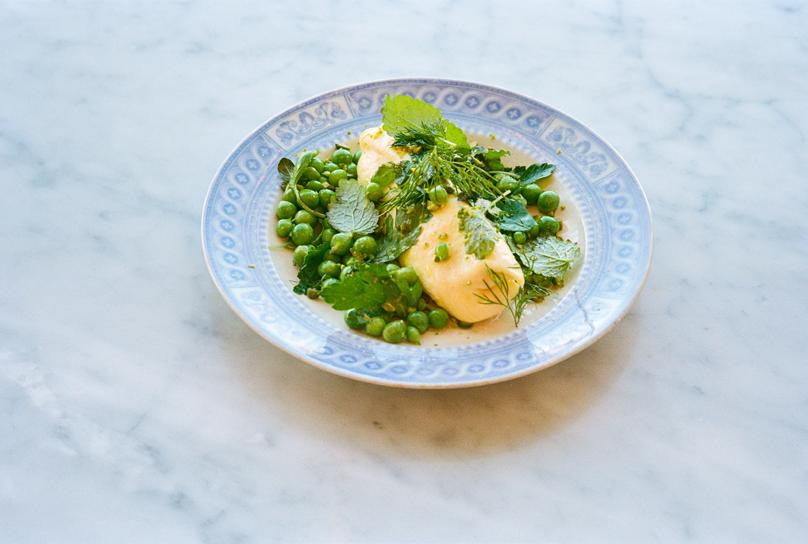
Instructions:
To make this a true summer dish, you need really fresh peas, and by that, I mean ones that have just been popped out of pods. These will have the best flavour and texture. The garnish is bursting with summer flavours of fresh herbs and new peas. An absolute delight. For one person, I like using two or three eggs, depending on their size, but the recipe can easily expand to accommodate more people.
Crack the eggs and either mix them in a blender or beat them super well with a whisk.
1. Take a 17-19cm non-stick frying pan and heat it to medium heat. Add a dash of olive oil.
2. To make one omelette, pour the egg mixture into the hot pan. Allow the mixture to spread over the surface.
3. Stir the mixture a little to distribute it evenly. As it begins to set, make sure it has flattened out.
4. Fold the sides into the centre to shape the omelette.
5. Flip it over to cook the top.
6. Slide the omelette onto a serving plate.
7. You can arrange the toppings however you like. We usually keep it pretty loose, just sprinkling them over the top and around the plate. Garnish with olive oil.


Kitakaruizawa, Japan

Words: Susanne Morell Adams
Photography: Kenta Hasegawa
In a world where architecture often competes with its environment, the NOT A HOTEL KITAKARUIZAWA project stands as a testament to the beauty of harmonious design.

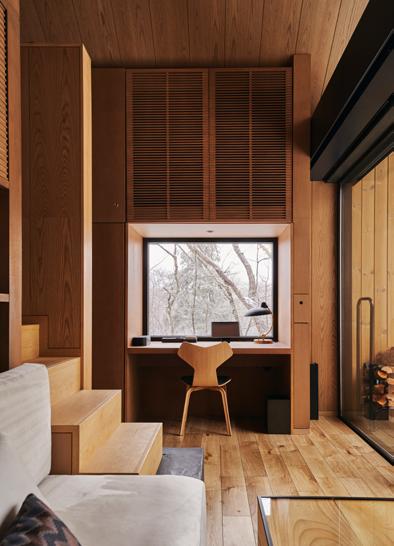

"Here, nature is an integral part of the living experience, inviting all who visit to slow down and appreciate the world around them."

Gently enhancing the comfort and atmosphere of the interior and outdoor areas with seating, lighting and sunbeds, the selected designs embody a minimalist, calm aesthetic, quietly inviting a uniquely memorable experience.
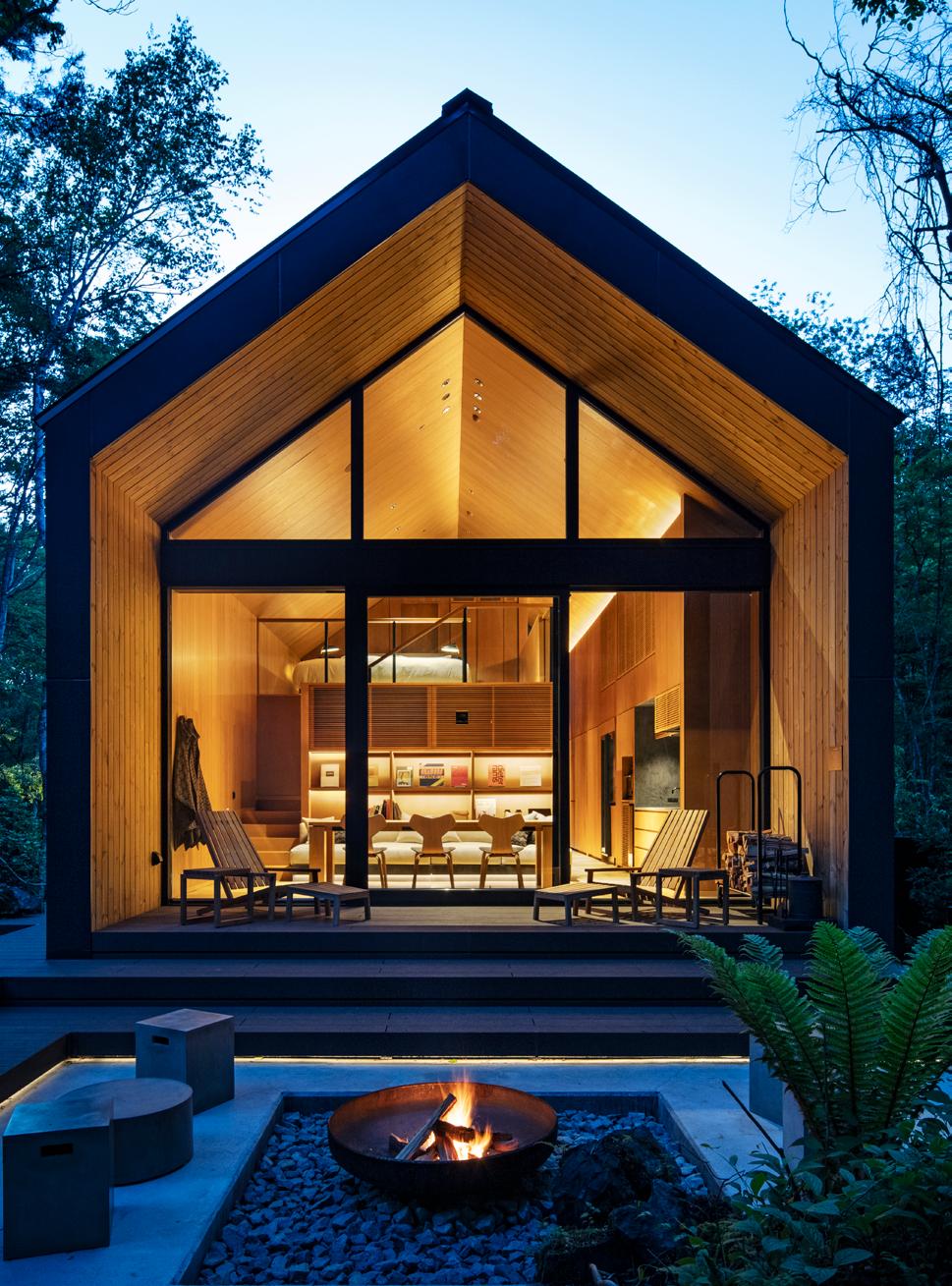
The design ethos centres around creating “BASE” accommodations that come in three sizes allowing guests to customise their experience. Whether it’s an intimate getaway for two or a lively gathering with friends, each accommodation emphasises the natural beauty surrounding the site. Guests experience an immersive nature experience where they can enjoy open-air fires, onsen hot springs, or outdoor cooking.
Fritz Hansen’s furniture selection plays a meaningful role in this project, chosen for its aesthetic appeal and functionality. Creative Director, Yosuke Aizawa, a resident of Karuizawa, expresses a personal connection to Fritz Hansen, having incorporated the brand into his own home and studio.
This project features the Grand Prix chair, upholstered in a unique fabric specifically designed for this space. “The Grand Prix chair has the power to enhance the atmosphere dramatically simply by changing its fabric or wood combination,” he notes, highlighting the thoughtful integration of design elements.
The architecture boasts an iconic triangular roof that not only elevates the space but also opens up to the incredible surroundings. This design choice fosters a sense of continuity between indoor and outdoor living, allowing natural light to flood the interior while providing a connection to the lush landscape outside. Equipped with the solar panel “Roof-1,” the structure exemplifies a commitment to sustainability, producing electricity without interrupting the pristine aesthetic.
With its meticulous attention to detail, the project transcends traditional hospitality by providing a serene space for reflection and connection. Harmonising tranquillity of nature with the surroundings, every aspect of the guest experience is considered. Gently enhancing the comfort and atmosphere of the interior and outdoor areas with seating, lighting and sunbeds, Fritz Hansen’s timeless designs embody a minimalist, calm aesthetic, quietly inviting a uniquely memorable experience. ■
NOT A HOTEL Kitakaruizawa is a unique hospitality concept offering private villa accommodations in Japan’s Kitakaruizawa region. The properties are designed by Yosuke Aizawa, founder of White Mountaineering.
We follow designer Hugo Passos down memory lane and to his favourite outdoor spots to get a sense of his summer. Born and raised in Portugal, Hugo moved to Copenhagen four years ago where he works as a designer creating furniture and objects that are as pleasing in function as they are in form. His work is rooted in a deep appreciation for the human scale of everyday design. Hugo’s work includes, among others, the Banco bench launched with Fritz Hansen in 2022.
Words: Susanne Morell Adams
Photography: Magnus Ekstrøm


What’s your first memory of summer?
The beaches along the coast of Serra da Arrábida in my hometown of Setúbal.
Is there an outdoor place that stands out specifically for you?
Maybe the pond with round stepping stones where I used to jump and play as a child.
Where do you like to go out and spend your summer days/summer nights in Copenhagen?
Bellevue beach, Palæ Bar, J.C. Jacobsens Have, Veranda, Fælledparken, Apollo Bar, Auren’s Deli, Osteria 16, Osborne pub and few others…
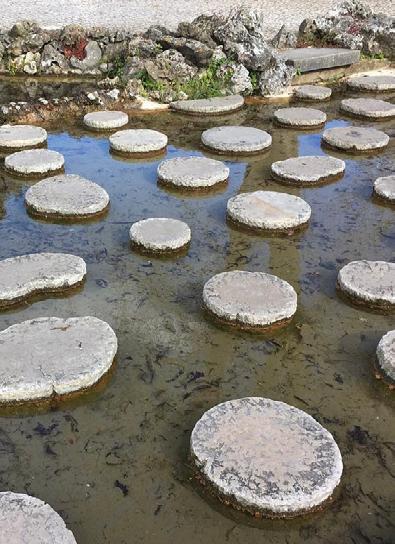


Fælledparken, Østerbro
Osborne pub, Elmegade 23, Nørrebro
Osteria 16 restaurant, Ravnsborggade 14B, Nørrebro
Assistens Kirkegård (Nørrebro cemetery), Nørrebro
Veranda bar, Griffenfeldsgade 17, Nørrebro
Palæ Bar, Ny Adelgade 5, Copenhagen city
Apollo Bar, Nyhavn 2, Copenhagen city
Garden of the Royal Library, Proviantpassagen 1, Copenhagen city
Auren’s Deli, Godthåbsvej 35, Frederiksberg
J.C. Jacobsens Have, Carlsberg City, Vesterbro
Your 3 favourite spots in your city for spending time outdoors?
The Royal Library Garden, Nørrebro cemetery, Veranda bar.
Your 3 favourite summertime activities? Cycling, cooking and meeting friends.
Your favourite summer drink? A good negroni.
Did you design the Banco bench for any specific occasion or place? And what was your thinking behind its design?
Banco was designed for an exhibition called ‘Public Seating’, part of the first Fiskars Village Art & Design Biennale 2019 in Finland. I chose to make a doublefacing bench integrated with a local tree as I tried to make it as pleasant as possible for people to enjoy the nature and surroundings. The sun moves so the double bench can be used on either side. While seeking to design a comfortable backrest I also wanted a beautiful, unexpected shape to break away from the long and straight lines of the seat planks.
The single-sided version of Banco came later, when I was asked (by Fritz Hansen) if I would be interested in turning the original idea into a collection for Fritz Hansen.■



Words: Rachael Morgan
Photography: Line Klein
Perched among Jutland’s windswept dunes, Svinkløv Badehotel offers a perfect escape into the heart of Danish summer. For owners Louise and Kenneth Toft-Hansen, the season is all about the quiet magic of nature and a slower pace of life.
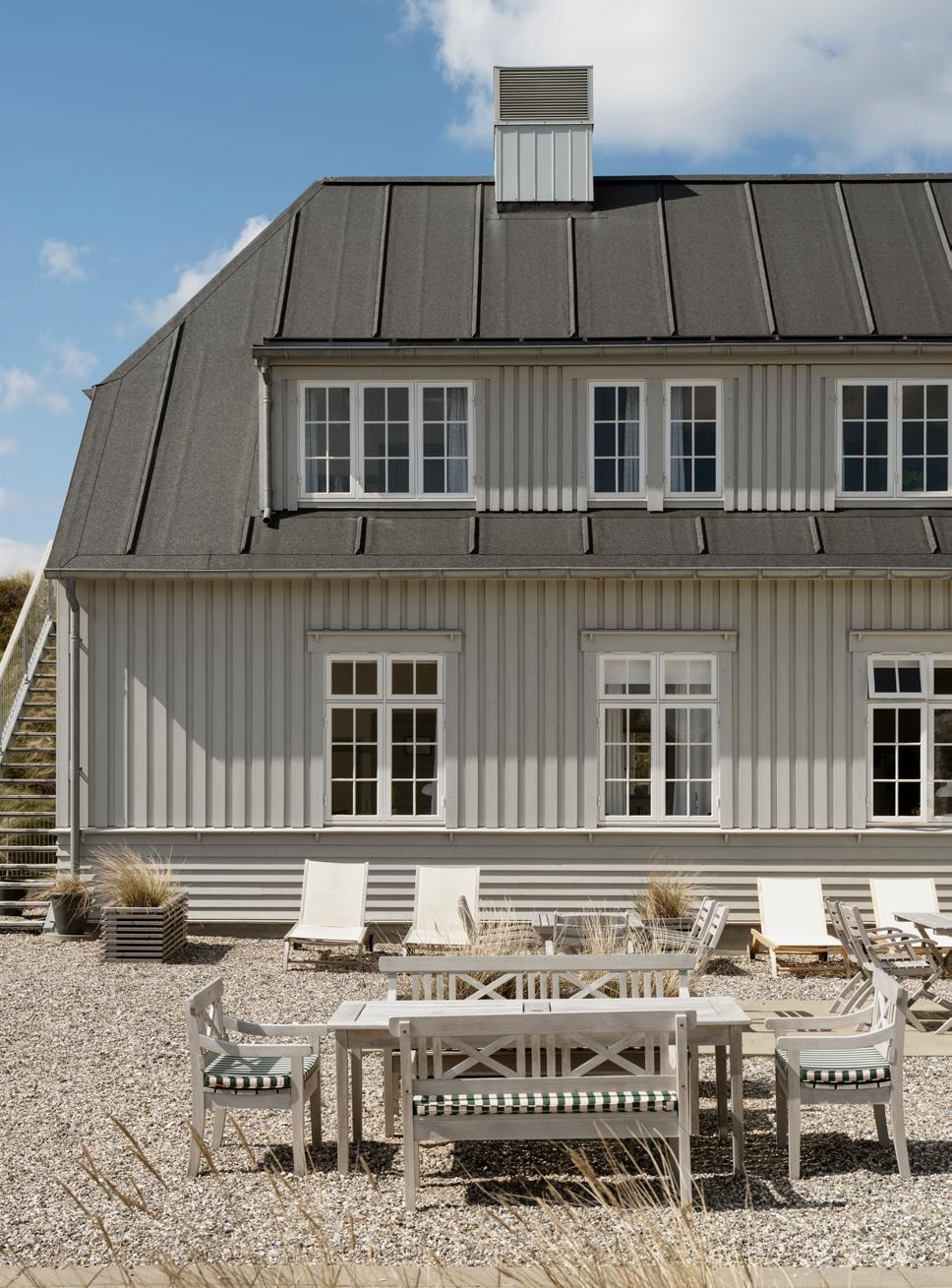

To Louise and Kenneth Toft-Hansen, owners of the celebrated Svinkløv Badehotel in northern Jutland, summer is a season that fully awakens the senses. ”When you live in nature as we do, all seasons are very distinct and noticeable, both visually and sensorially,” explains Louise. ”The contrasts are striking. But what’s especially unique here are the long, bright, beautiful nights. It almost feels as though night never truly falls.”
For more than a century, Svinkløv Badehotel has been a place of quiet escape. Nestled among windswept dunes, with the vast North Sea stretching endlessly beyond, the hotel is a haven of understated elegance that honours the outdoors during the precious summer months. It is a place where time slows, where salty sea breezes mix with the scent of pine, and where guests are invited to embrace the simplicity of summer — long swims, leisurely dinners and a welcome digital detox.
Taking a ‘less is more’ approach to emphasise nature as part of the interiors, tables are dressed in white tablecloths and complemented by the Vester Chair, the customdesigned dining chair created by Chris L. Halstrøm.
”The nature here invites peace and quiet contemplation,” says Kenneth. ”We encourage our guests to go off-the-grid for a while, to breathe deeply and tune into their senses.” It is this dedication to a slower pace of life that keeps visitors returning, year after year.
The couple’s own summer rituals reflect this unhurried pace. At home, their terrace becomes the heart of living. ”The outdoor space is the most important room in summertime and it’s where we spend most of our time,” Louise shares. She describes the magic of being the first to wake, sneaking downstairs to make a cup of coffee before settling onto their Drachmann bench: ”It’s a truly magical and life-giving morning moment where I find peace.”
For the Toft-Hansen family, summertime is all about making the most of the great outdoors. ”We try to slip away to the beach for an afternoon or evening dip as often as we can,” says Louise. ”Kenneth is often at the hotel for the evening service, but sometimes there’s time for a quick swim together before work. Our boys love the beach and it’s a fantastic way to wash away the day and enjoy some quality family time.”
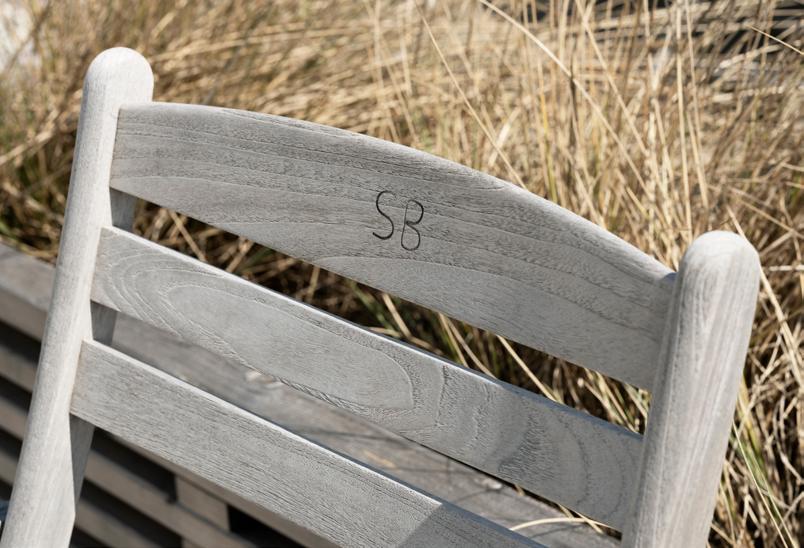
In the salty, windswept air of Northern Jutland, teak patinates more quickly, transforming into a soft, silver-grey hue. On the left, the Selandia Chair shows this natural shift, while the England Bench on the right blends effortlessly into the coastal landscape.
"We try to let the spectacular nature around us be the allencompassing wow factor"

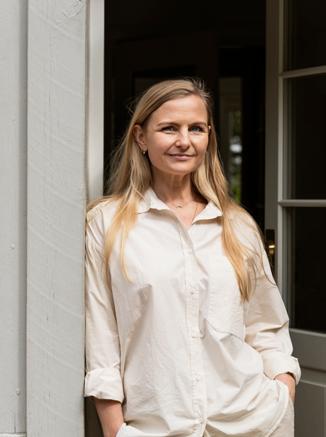
Evenings are equally treasured: grilled dinners, the freshest summer produce and a glass of chilled white wine in hand. The children play at the forest’s edge, while the sky turns golden over the dunes. It’s the kind of simple perfection that makes summer unforgettable.
This seamless indoor-outdoor connection is carefully cultivated throughout their spaces. ”We try to let the spectacular nature around us be the all-encompassing wow factor,” explains Kenneth. Every element at Svinkløv Badehotel is designed to honour the landscape. Natural materials, a muted palette that echoes sand and sea, and simple, timeless design allows ”the magnificent and unspoiled surroundings” to take centre stage.
From early mornings on the terrace to golden-hour swims, the family savours every summer moment. ”Breakfast on the terrace, a bike ride to the beach, fresh peas, new potatoes, bonfire bread and homemade koldskål. Watching the children play as we enjoy the most beautiful sunset over the North Sea. That’s the perfect summer day.” And in these simple, sundrenched moments, the magic of summer comes alive.
It’s an ethos shared with Fritz Hansen, whose iconic outdoor furniture holds court on the couple’s terrace and hotel grounds. ”The craftsmanship and beautiful natural materials go hand-in-hand with the landscape here,” notes Louise. ”If you give them a little love, they can last a lifetime while developing such a beautiful patina that fits perfectly into the surroundings.” ■



buttermilk dessert)
Serves 4-6
6-7 egg yolks, depending on size
50 g cane sugar
1 vanilla pod of good quality
2 dl yogurt
1 dl elderflower syrup
7 dl buttermilk
A pinch of salt
1 organic lemon, juice and zest
Instructions:
1. Scrape the vanilla seeds from the pod and crush them into the cane sugar
2. Whisk the egg yolks, vanilla sugar, and salt until it becomes white and airy.
3. Stir in the yogurt, buttermilk, and elderflower syrup.
4. Taste and adjust with a bit of lemon juice and grated lemon zest.
Tip: If you don’t have elderflower syrup, it can be omitted. In that case, you can increase the cane sugar to 65g.
Born in Wuhan, China, and raised in Sweden, architect Xiao He has long navigated the intersection of two cultures. After studying in Sweden and Hong Kong and working with established firms, she founded Studio He in 2019, shaping a practice that thoughtfully balances material sensitivity, nature, and a refined approach to contemporary design.
Words: Susanne Morell Adams
Photography: Line Klein

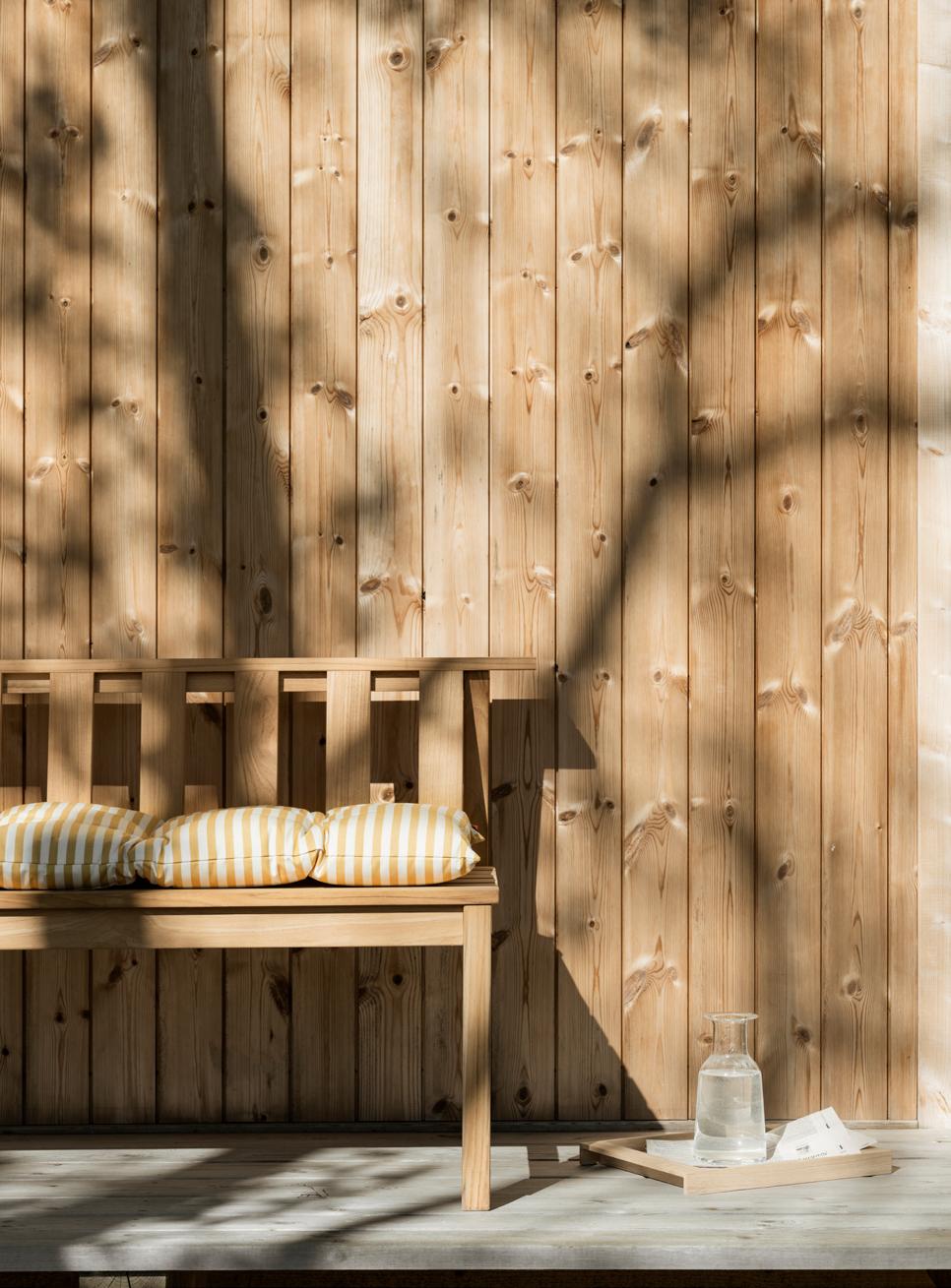

Light plays a defining role in her work, a fascination shaped by life in Sweden, where its scarcity through much of the year intensifies appreciation for its presence. ”The shifting colours of light and the way they signal the seasons shape our moods and routines,” she reflects. This awareness informs her design philosophy, where architecture exists in dialogue with nature rather than apart from it.
Nowhere is this more evident than at Nabben, He’s private summer retreat, where her approach to materials, light, and seamless indoor-outdoor living takes on its most personal form.
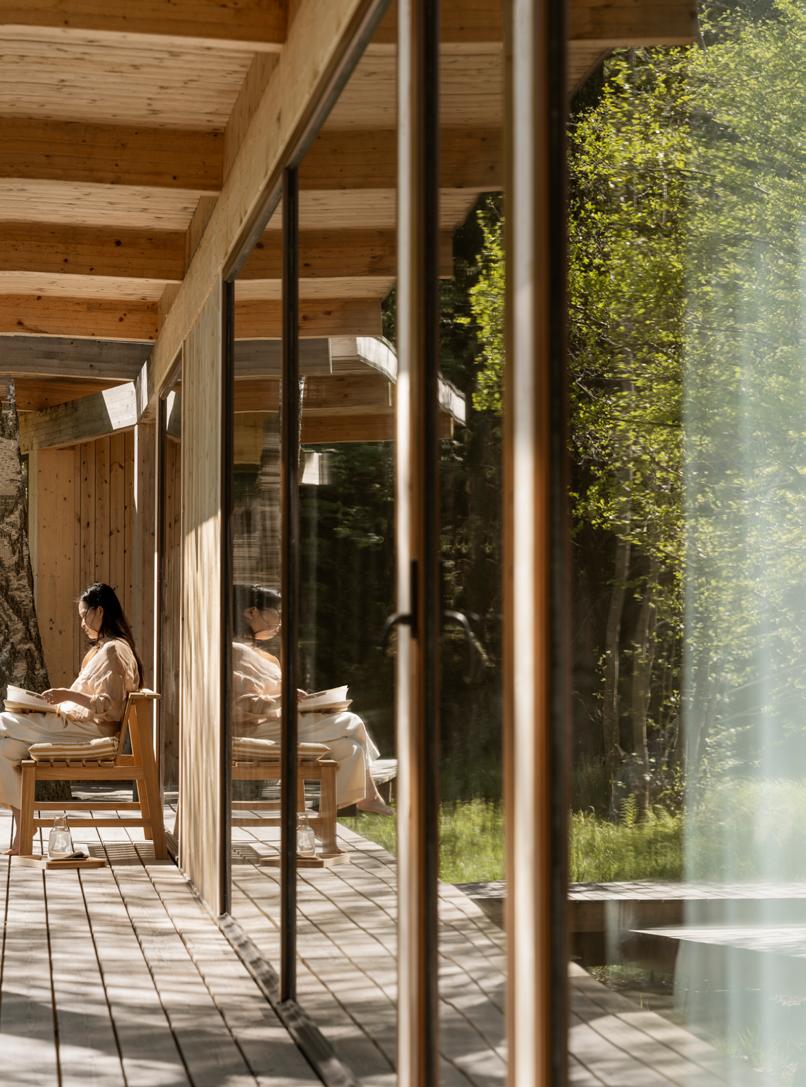
For He, summer in Sweden is a season of unhurried elegance, where the absence of rigid schedules invites a slower pace of life. ”The freedom of summer means embracing spontaneity - whether it’s an afternoon nap under a tree, roasting marshmallows by the fire, or a visit to the local market with no agenda.” At Nabben, these simple pleasures unfold in a setting designed to dissolve the boundaries between built space and the surrounding landscape.
Nestled within a marshy terrain, Nabben’s design embraces the seamless transition between indoors and out. A continuous terrace encircles the house, while lowered window thresholds allow effortless movement between spaces - where carpets, cushions, and life itself can be carried freely between the two realms. Instead of a conventional outdoor kitchen, He designed the kitchen with sliding glass walls that open in two directions - one leading to a dining area with a grill, the other to a lush herb garden, ensuring that nature is always within reach.
A sprawling dining area between the main house and guest quarters, where summer gatherings unfold under the open sky. ”It’s spacious enough for 30, yet intimate enough to feel like an extension of the home.” Whether celebrating Swedish Midsummer or simply enjoying a quiet evening meal, it’s a place where architecture and nature meet in perfect balance.
Summertime at Nabben is defined by cherished rituals, from slow mornings to adventurous afternoons. “Our perfect summer day begins with the rare luxury of a full night’s sleep with three small children,” she laughs. ”We wake up, enjoy a leisurely breakfast, and let the day take its course.” Often, this means gathering friends and family for an
impromptu beach trip or exhilarating motocross rides on a track her husband has built nearby.
As the day winds down, a beloved evening ritual unfolds. “Even in summer, a hot bath is a daily indulgence,” He shares. As dinner is prepared over the open flames of the grill, a wood-fired bathtub slowly heats up. Later, with the kids in bed, she steps into the warm water - a glass of wine in hand, a podcast playing, and the evening settling in around her. ”Just thinking about it, I can already feel the relaxation enveloping my body.”
As twilight deepens, nature takes centre stage. ”We watch the night shift begin - the roe deer, moose, foxes, and hares emerging from the forest. It’s moments like these that stay with us, defining what summer at Nabben is all about.”
At the core of He’s architectural philosophy is the belief that a truly exceptional house should enhance its surroundings. ”When designing a new building, the question should always be: How does this structure elevate the environment it belongs to?”This perspective informs her material choices, with a deep affinity for wooda renewable resource that offers both aesthetic versatility and sustainability. “It’s a material that can be left raw, carved with precision, or engineered for strength, making it endlessly adaptable.”
Sustainability, for He, goes beyond materials - it’s about longevity. ”The most sustainable design is one that people truly cherish, care for, and keep for generations.” This philosophy aligns with her approach to furniture and objects, where craftsmanship and purpose define what endures.

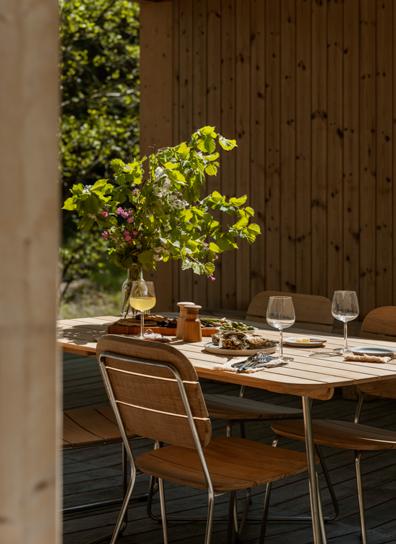
Her appreciation for Fritz Hansen’s outdoor furniture stems from this very principle. ”Their designs turn outdoor spaces into destinations of their own. Our two lounge chairs epitomise timeless elegance and genuine craftsmanship, adding a touch of sophistication to our outdoor sanctuary. They invite us to create special moments, whether it’s watching the sunrise, unwinding at the end of the day, or making memories with loved ones.”
At Nabben, this connection between design, nature, and daily life comes full circle. ”For the love of leisurely breakfasts with loved ones, refreshing dips in the wood-fired bathtub, and the harmonious blend of natural elements and thoughtful architecture, summertime at Nabben becomes an enchanting sanctuary where every detail fosters a sense of serenity and connection.” ■

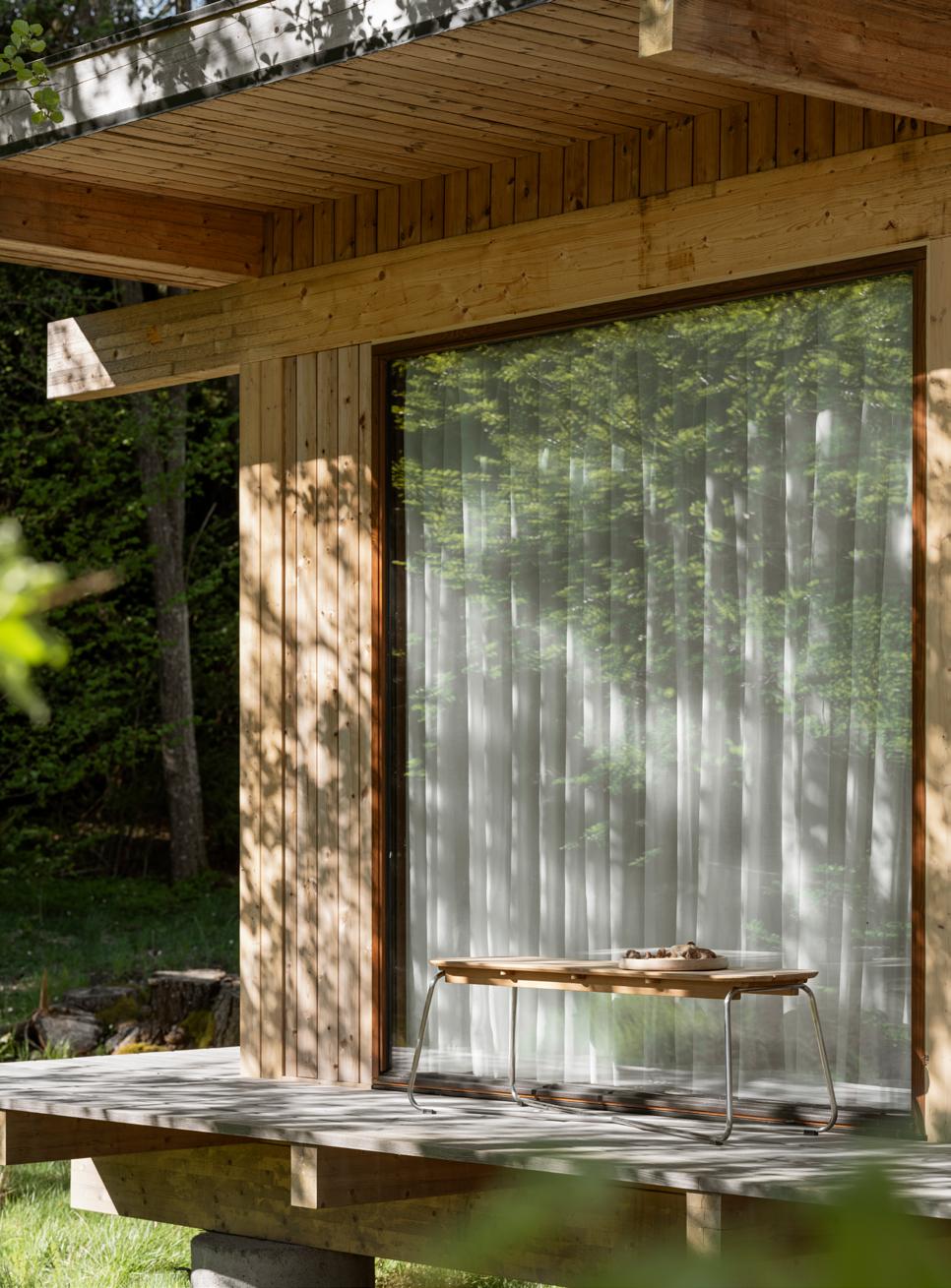


Words: Susanne Morell Adams
Photography: Magnus Ekstrøm


We catch up with Sanna Wåhlin, interior architect and partner at Note Design Studio, to explore her summer inspirations. Known for creating spaces that balance materiality, history, and emotion, Sanna brings the same thoughtful approach to furniture design. Note is the studio behind the Pelagus series - a minimalistic outdoor collection with slim lines, exquisite materials, and a fresh, contemporary feel. Perfect for social summer days, it reflects her eye for effortless, enduring design.
Where were you born and where do you currently live with your family?
I was born in Småland, the southeast side of Sweden, where much of the furniture and glass industry in Sweden is located. After 16 years in Stockholm, I now live in Malmö with my family.
My first memory of summer is… playing with my friends outside in the late summer evening, not ever wanting to go inside. In Sweden summer evenings are very bright, it hardly feels like evening or night at all. When our parents told us to come inside and go to bed we just couldn’t accept it! It was a feeling of freedom and the wish that we could go on playing forever!
Is there an outdoor place that stands out specifically for you?
My garden at my summer house in southern Sweden. It’s just paradise to me. It is such a vital place, nature there is bursting with energy, everything grows so fast, just explodes out of the soil. The landscape is open, the horizon is wide and the ocean is nearby. It’s wild and untamed and natural.


How long have you had the summer house for?
We bought it when our first child was 1 year old, so 9 years ago. It had then been abandoned for 10-15 years, so it was very damaged and run down. But the scenery outside gave it a huge potential!
Where is the summerhouse located and what is specific about the house and the area?
To me, Österlen is the most beautiful part of Sweden. The landscape is open, fields flow on and on, and there is so much horizon and sky! You are always close to the sea, and the beaches consist of the finest white sand. To me it is pure beauty.
Pastafabrikken is a favourite haunt of Sanna who comes here for the delicious handmade pasta dishes, made with fresh local ingredients and inspiration from their farm which is just outside the door. Outside the restaurant, several of her studio’s Pelagus tables and chairs invite guests to dine.
Find Pastafabrikken’s recipe for tortelloni with ricotta, sage, and browned butter on page 124.


Where do you like to go out and spend your summer days/summer nights in Sweden or somewhere else?
Since summers in Sweden are quite short, and it’s my absolute favourite time of year, I want to capture every moment of it, and don’t go anywhere else. I want to enjoy it in the most simple way. On the grass, on the sand, by the sea. The beaches in the south of Sweden are magical, no need to travel anywhere else. On a sunny day, I might take the boat to Ven, the small island between Denmark and Sweden, where there are no cars, and you bike around the island and then take the boat back in the evening. We have done that nearly every summer since I was a kid, it is such a sweet thing to do.
What is your recipe for a perfect summer evening?
Best friends. Dinner and drinks. Music. Surrounded by nature.My favourite spots in the city for spending time outdoors is…I love city life, but I don’t want to be in the city during summer.

Your favourite summertime activities?
1. Being at any (sandy) beach. I love sand. Even want it to end up traces of it in the car so I am reminded of summer later in the fall…
2. Garden work. I can spend endless hours weeding, sowing, watching the plants as they grow. I check on my plants many times a day. Gardening is what I see myself spending time doing when I grow old(er).
3. Eating outdoors. Any meal of the day, anywhere outside really. In the garden, in a restaurant, by the sea… It’s just a different experience eating outside.
4. Biking. I ride my bike to get to most places as I don’t have a driver’s licence. But it is just a very summertime thing to do.
Your favourite summer drink? Wine. Or anything with lemon. ■




Thinly rolled pasta cut into squares then filled, folded, and shaped. Making homemade tortelloni is easier than you might expect and totally delicious.
Serves 6-8
Pasta dough
400 g durum wheat flour
4 eggs (4 eggs equals about 240 g)
Instructions:
1. Pour the flour into a pile on the worktop.
2. Form a large hole in the middle.
3. Crack in the eggs.
4. Beat the eggs with a fork and whisk in a little of the flour at a time.
5. When the flour and eggs have come together, knead into a smooth dough for about 5 minutes. Divide the dough into two pieces and cover with plastic wrap. Place in the fridge about 1 hour.
TORTELLONI
Browned Butter
150 g butter
100 ml fresh sage leaves
50 ml fresh thyme
1 tbsp freshly squeezed lemon juice
Filling
250 g ricotta cheese
200 ml grated parmesan
1 tbsp finely grated lemon zest
2–3 tbsp freshly squeezed lemon juice
2 pinches of salt
1 pinch of black pepper
Instructions:
1. Make the Filling – Mix all the filling ingredients in a bowl.
2. Brown the Butter – Melt the butter in a saucepan until it turns golden brown. Add the herbs and remove from heat. Stir in the lemon juice.
3. Shape the Tortelloni
Roll out the pasta dough using a pasta machine or by hand until about 1 mm thick.
Cut into 8x8 cm squares.
Place about 1 tsp of filling in the centre of each square and lightly brush the edges with water.
Fold one corner over to form a triangle, ensuring all air is pressed out.
Fold the filled section toward the tip, lift the tip, and overlap the corners toward yourself.
Pinch the corners together to seal.
4. Cook the Tortelloni – Boil in salted water for about 3 minutes. Drain, reserving 50 ml of pasta water (for 4 servings).
5. Combine & Serve – Toss the tortelloni in the browned butter along with the reserved pasta water. Serve topped with extra parmesan and freshly ground black pepper.
Enjoy your homemade tortelloni!

For Marianne Tromborg, the visionary behind the Tromborg beauty brand, summer is a time that fully awakens the senses. ”When you work with scents as I do, I always look forward to everything blooming and having your senses bombarded with the most fantastic plants – lilacs, hawthorns, herbs. That’s the scent of summer for me,” she reflects.



Marianne’s summer rituals are steeped in tradition and joy. Every year, she celebrates Midsummer on her beachfront property, a ritual that has grown even more special with the arrival of her grandchildren. ”All the houses along the beach light bonfires that stand like small lighthouses on the horizon along the water’s edge. Luckily, we always have good weather,” she notes with a smile. The evening is filled with grilling fresh vegetables and enjoying an abundance of strawberries and peas – a true celebration of the season’s finest produce.
When Marianne has a day off and the Danish weather is favourable, her ideal summer day is spent under the shade of trees with a stack of books and the sound of the sea in the background. ”It’s completely magical,” she describes.


"It’s wonderfully capricious – but when the weather is good, I wouldn’t want to be anywhere else but here at home in Denmark"
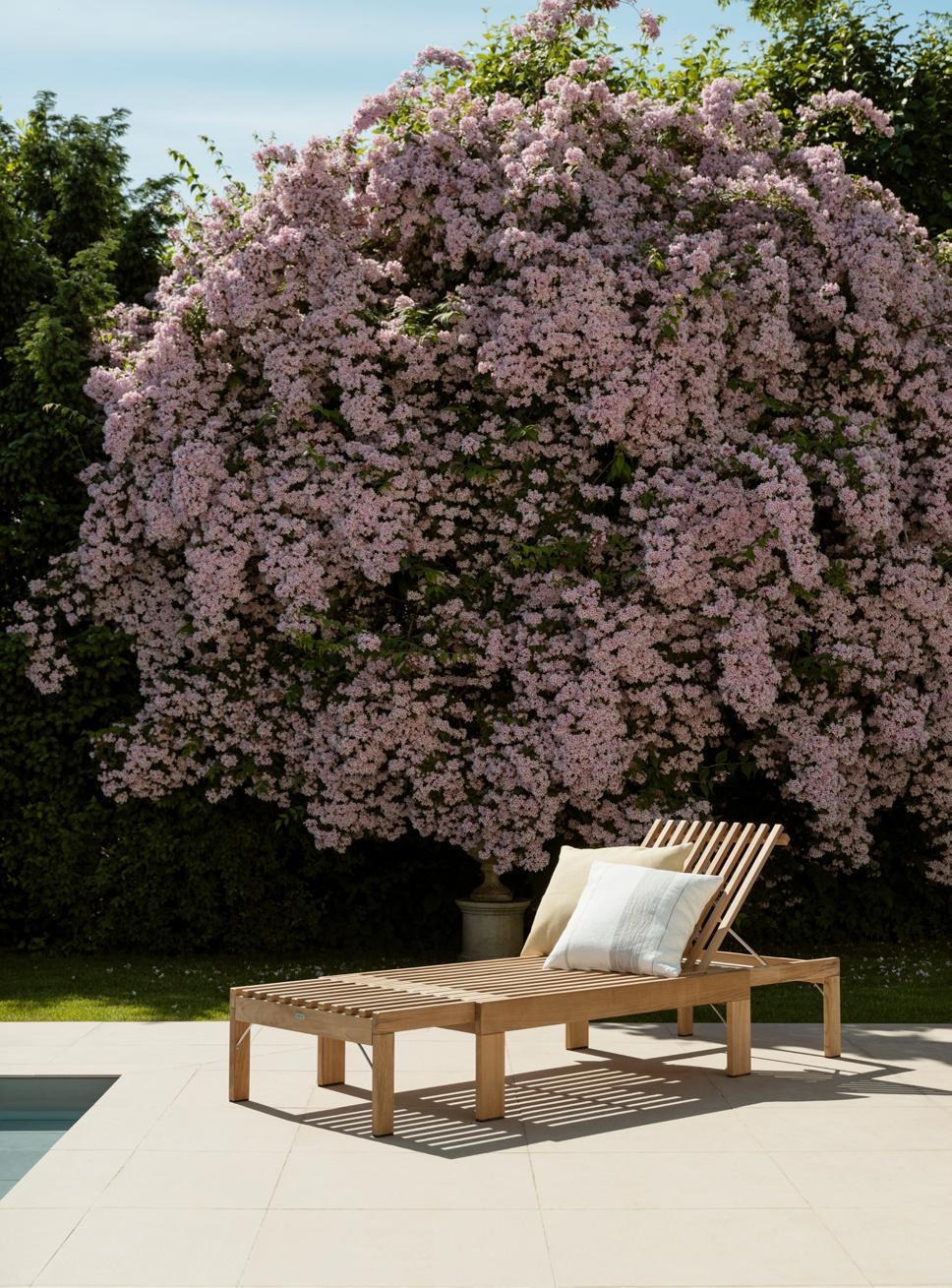
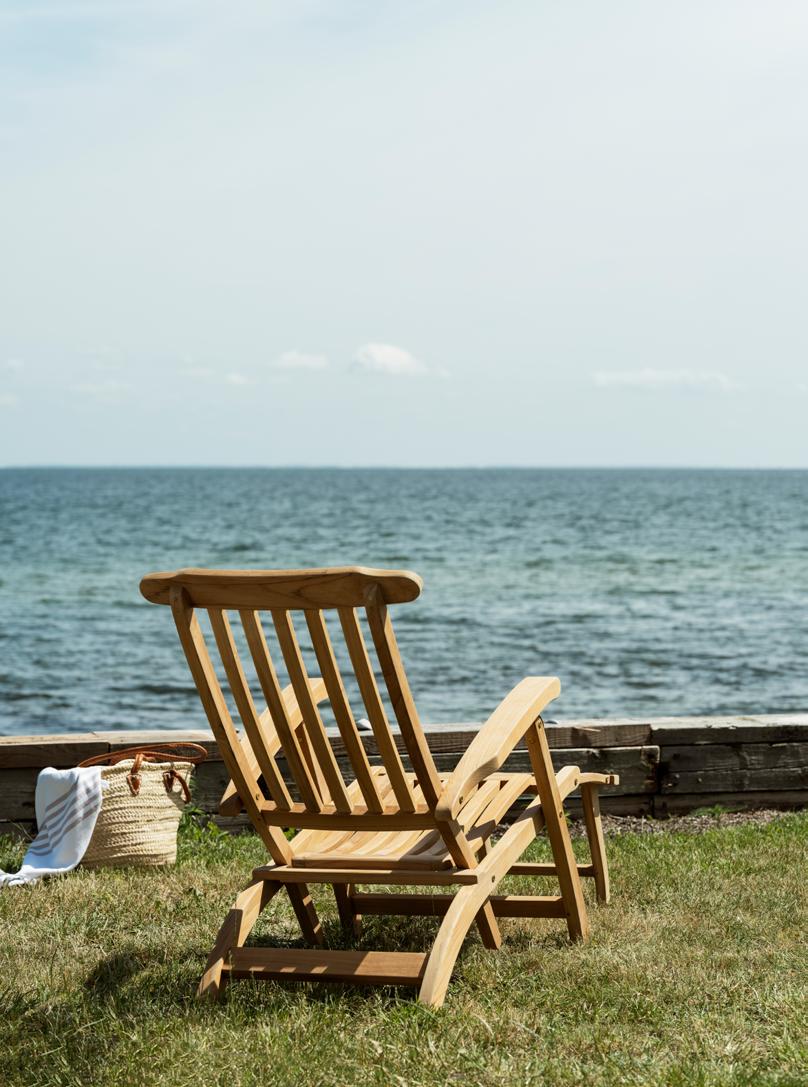
The day often concludes with a relaxing boat ride. Her husband of 30 years, who is also Tromborg’s biochemist, takes the helm. ”He is the captain and has the ’driver’s license’ for the boat,” she shares.
Summer in Denmark holds a special place in Marianne’s heart. ”It’s wonderfully capricious – but when the weather is good, I wouldn’t want to be anywhere else but here at home in Denmark,” she emphasises.
Living near the water provides a serene escape from a busy life. ”There’s nothing more blissful than hearing the waves lapping and looking out over the horizon,” she reflects. ”It’s quite amazing that regardless of the weather, our view is always magical.”
Deciding between the beach and her beautiful terrace is not an easy choice for Marianne. ”I’m often on the beach during the day and then spend the evening on the terrace, where I can look out over the water or take a dip in the pool,” she says. Marianne enjoys relaxing in her Riviera sunbed with a stack of books, indulging in her love for reading.


The garden at Marianne’s home serves multiple purposes. ”It’s a space for creativity, play, celebration, and joy – for both the young and old, and our cat Bleu,” she explains. Though their home is relatively new, Marianne has a deep connection to the garden. ”I’ve been fortunate that my ginkgo biloba – also known as the temple tree – has followed me through my previous homes, including this one,” she says. Prioritising herbs, lavender beds, and fragrant plants, she balances the garden with a swimming pool. ■

As summer invites slower mornings and sunlit afternoons, Els Van Hoorebeeck, Creative Director at Fritz Hansen, shares her personal reading recommendations for the season—a thoughtful blend of fiction, non-fiction, and design.
“I adore spending summertime in Copenhagen. My ideal morning begins with a refreshing swim, followed by savoring a delicious cup of coffee while diving into a captivating book. This routine is my favourite way to start the day. I enjoy books that transport me to different eras and locations, offering both escapism and valuable lessons.”
1. Pachinko by Min Jin Lee (fiction)
This book might look substantial in volume, but it is so captivating, you read it in one go. It is an epic, multigenerational story about the search of belonging in an often hostile world. This is my one book I recommend everyone to read.
2. What Artist Wear by Charlie Porter (non-fiction)
This is a socio-cultural study of artists’ wardrobes as extensions of their identities. It blends cultural history with contemporary analysis. It gives you an insight in how artists portray themselves in relation to their art. It’s inspirational and entertaining.
3. Noguchi – East and West by Dore Ashton (non-fiction)
This book explores how the Japanese-American sculptor navigated his dual cultural identity and how it influenced his art. I have always been intrigued by Noguchi and this book really gives you an understanding of the man behind the art.
4. Before the coffee gets cold by Toshikazu Kawaguchi (fiction)
This is quite a heartwarming and melancholic book. It is a very moving story that stays on your mind, much like a good cup of coffee. Sidenote: there will be tears.
5. Archetypes by Michael Sheridan (non fiction)
Working with a Danish design legacy, this book is a must for design enthusiasts, going in-depth with 21 iconic Danish design objects that were created between 1940 and 1980.





ACROSS:
1. Portable food carrier for outdoor dining (6,6)
6. Burn outdoor logs here (4,3)
10. Tree collection on display (9)
12. Grill event where things heat up? (8)
13. Spring month, perhaps? (3)
14. Result of some exposure? (3)
15. One who might grant three wishes (5)
16. Absolutely necessary (9)
18. Jaime Hayon’s “tranquil” chair? (2)
19. Clear-headed and serious (5)
21. Hazy atmosphere, perhaps? (4)
22. No longer in the bank (5)
23. Direction, or a Pixar adventure? (2)
25. Quick knock or music genre (3)
26. Iconic chair or breakfast staple (3)
27. Split in the hemispheres (7)
29. _ _ _ Trio: Ole Palsby’s kitchen wares (3)
30. I, myself (2)
31. You might use one to move the boat (3)
32. Shady outdoor structure (6)
34. Utterly transcendent (7)
36. Spring bloom or part of the eye (4)
37. Surprised sound (2)
39. Carrier tied to landmark Copenhagen hotel (3)
40. Tear or a final farewell (3)
41. Here, in France usually (3)
42. If not _ _ _, when? (3)
44. Kasper who made a Little Friend? (5)
46. Grab a bite (3)
47. Throw (3)
48. In a tidy manner, perhaps? (6)
49. Utensil for soup or cuddling (5)
51. Picture this (5)
52. French-speaking Caribbean nation (5)
54. Tropical symbol swaying in the breeze (8)
56. Endless blue expanse (5)
59. Involuntary twitch (3)
60. Tropical fruit that sparks pizza debates (9)
61. Beyoncé’s “squeezed” album (8)
1. Holder for greenery, perhaps on a patio (7)
2. Poolside shelter, often with curtains (6)
3. They study flora (9)
4. Warm weather waft, or a soft rock hit (6,6)
5. Not taxing at all (4)
7. Bird that signals spring (5)
8. Outdoor meal, often with a basket (6)
9. Climbing plant’s framework (7)
11. Act of renewal or growth (12)
16. He was eager to phone home (2)
17. Longest day of the year (6, 8)
20. It can really tie the room together (3)
22. Detailed description of requirements (13)
24. Scary clown in Maine? (2)
25. Connection between two people (12)
28. Rain shield or beach shade (8)
30. University degree or mother, casually (2)
31. Usually followed by the Aahs, amazingly. (4)
33. It floats (4)
35. What builds wisdom (10)
38. It’s mine! (3)
40. Dressing gown, perhaps (4)
43. Sudden urge to act (7)
45. A measure of thermal insulation or clothing, informally (3)
46. Signifier for English language (2)
50. Big name in plant-based milk (5)
53. Glass on the radio? (3)
54. Music genre or a quick sound (3)
55. Slippery swimmer (3)
57. Approximate arrival indicator (3)
58. Help (3)
If you need the answers, let us know! Send a DM to our Instagram account @fritzhansen, and we’ll send them to you.
EDITOR
Emilie Luna Krog Aagaard
GRAPHIC DESIGN
Maja Langkilde
PHOTOGRAPHERS
Line Klein, Birgitta Wolfgang, Emilie Holm, Madeline Tolle, Kenta Hasegawa, Magnus Ekstrøm
WRITERS
Susanne Morell Adams, Rachael Morgan
PRINTING
Narayana Press, 2025 www.narayana.dk
CONTACT
Headquarter
Fritz Hansen
Allerødvej 8 3450 Allerød Denmark
Tel: +45 48 17 23 00
NEWSLETTER
Sign up at: fritzhansen.com/sign-up
FOLLOW US
INSTAGRAM: @fritzhansen
PINTEREST: @fritzhansen
FACEBOOK: Fritz Hansen
LINKEDIN: Fritz Hansen


Through these stories, recipes, and guides, we’ve glimpsed the quiet magic of outdoor living in the summer months. Outdoor furniture tells the story of the season - patinated wood, softened fabrics, and surfaces that catch the light just so. Even as the seasons change, the traces of summer remain, woven into the spaces we create.
From all of us at Fritz Hansen, we wish you a wonderful summer.